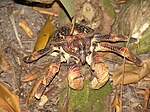The coconut crab, Birgus latro, is a species of terrestrial hermit crab, also known as the "robber crab" or "palm thief". It is the largest land-living arthropod in the world, and is probably at the upper size limit of terrestrial animals with exoskeletons in today's atmosphere at a weight of up to 4.1 kg (9.0 lb). It is found on islands across the Indian Ocean and parts of the Pacific Ocean as far east as the Gambier Islands, mirroring the distribution of the coconut palm. Adults develop a tough exoskeleton on their abdomen and stop carrying a shell. They cannot swim, and will drown if immersed in water for long. Sexual maturity is reached after about 5 years, and the total lifespan may be over 60 years.
Adult coconut crabs feed on fruits, nuts, seeds, and the pith of fallen trees, but will eat carrion and other organic matter opportunistically. The species is popularly associated with the coconut, and has been widely reported to climb trees to pick coconuts, which it then opens to eat the flesh. While coconut crabs can climb trees, and can eventually open a coconut collectively, coconuts are not a significant part of their diet. Coconut crabs are hunted wherever they come into contact with humans, and are subject to legal protection in some areas. In the absence of precise information, the IUCN lists the species as Data Deficient.
